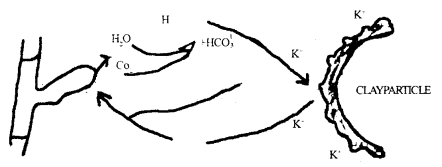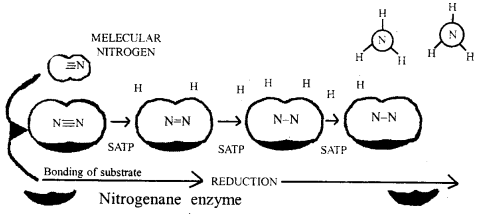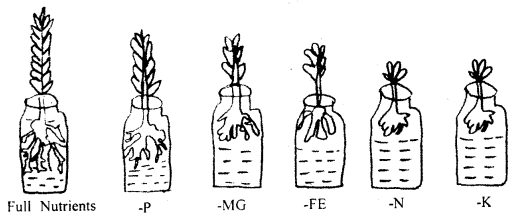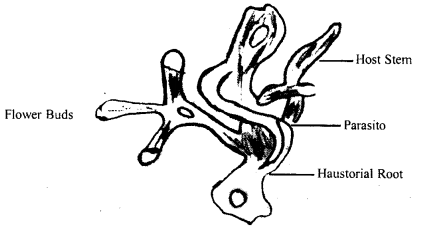Here we are providing Class 11 Biology Important Extra Questions and Answers Chapter 12 Mineral Nutrition. Important Questions for Class 11 Biology are the best resource for students which helps in Class 11 board exams.
Class 11 Biology Chapter 12 Important Extra Questions Mineral Nutrition
Mineral Nutrition Important Extra Questions Very Short Answer Type
Question 1.
What is tank farming?
Answer:
It is growing plants in water or solution culture.
Question 2.
Name any nitrogen-fixing symbiotic bacteria.
Answer:
Rhizobium.
Question 3.
What is necrosis?
Answer:
The death of tissues and cells and usually results in holes in the leaves is called necrosis.
Question 4.
Name the bacteria which convert ammonia into nitrite.
Answer:
Nitrosomonas.
Question 5.
What is the major role of calcium?
Answer:
It is a constituent of calcium pectate of the middle lamella of a cell wall.
Question 6.
What is chlorosis?
Answer:
Yellowing of leaves in a distinctive pattern due to lack of one or two other elements is called chlorosis.
Question 7.
From where do the plants get hydrogen?
Answer:
From the water absorbed by the plants.
Question 8.
What are hunger signs?
Answer:
Morphological abnormalities caused due to the deficiency of one or- the other essential elements.
Question 9.
What is premature abscission?
Answer:
Fall of leaves, flowers, or fruits before their maturation is called premature abscission.
Question 10.
Name two micronutrients.
Answer:
Boron, Copper,
Question 11.
Define hydroponics.
Answer:
The technique of growing plants in a nutrient solution is known as hydroponics.
Question 12.
What is the toxicity of micronutrients?
Answer:
Any mineral ion concentration in tissues that reduces the dry weight of tissues by about 10 percent is considered toxic.
Question 13.
What is nitrogen?
Answer:
Nitrogen is a constituent of amino acids, proteins, hormones, chlorophylls, and many vitamins.
Question 14.
Define nitrogen fixation.
Answer:
The process of conversion of nitrogen (N ) to ammonia is termed nitrogen fixation.
Question 15.
Define the biological nitrogen fixation.
Answer:
The reduction of nitrogen to ammonia by living organisms is called biological nitrogen fixation.
Question 16.
Write the two deficiency symptoms of molybdenum.
Answer:
- Premature falling of flowers.
- Low levels of as carbic acid arid reduced organic nitrogen content.
Mineral Nutrition Important Extra Questions Short Answer Type
Question 1.
What are chelators or chelating agents?
Answer:
These are usually organic chemicals that hold or bind iron in the form of soluble complexes to make available iron to the plant. The chelator itself is not taken up by the plant. EDAA (Ethylene Diaminotetra Acetic Acid) is a commonly used chelator in water culture experiments.
Question 2.
What type of condition is created by leghaemoglobin in the root nodules of the legume?
Answer:
Leghaemolobin is an oxygen scavenger, it creates anaerobic conditions in the cells of root nodules and protects the nitrogen-fixing enzyme nitrogenase of the bacteroids.
Question 3.
What are micronutrients? Give examples.
Answer:
The elements that are required by the plants in fewer amounts or traces are called micronutrients e.g. B(Boron). Mo (Molybdenum). Mn (Manganese). Cl (chlorine). These elements are present in plant tissues. They mostly act as cofactor or activator of enzymes.
Question 4.
Some bags of fertilizers are labeled 15 – 15 – 15. What does it mean?
Answer:
The number 15 – 15 – 15 on the bags indicates the percentage by weight of nitrogen, phosphorus, and potassium in the chemical fertilizer. The majority of the fertilizers contain these elements in bulk such fertilizers are called complete fertilizers. Common fertilizers consist of chemicals either singly or in various compositions like urea, nitrate of soda, ammonium sulfate, etc.
Question 5.
What do you mean by mineral nutrition?
Answer:
The utilization of minerals by plants for growth and development is called mineral nutrition. The minerals are obtained from the soil for their growth. Plant analysis reveals the presence of a large number of minerals and nutrients in the soil. The number and amount of the mineral elements present varies from plants to plant/
Question 6.
Differentiate between micronutrients and macronutrients:
Answer:
Difference between micronutrients and macronutrients:
| Micronutrients | Macronutrients |
| 1. These are present in plant tissues in larger concentrations and are known as major elements. | 1. These are present in plant tissues in relatively smaller concentrations and are thus known as trace elements. |
| 2. Their concentration in plant tissues is 1mg or more per gram of dry matter of plant. | 2. Their Concentration in plant tissues is less than 1mg per gram of dry matter of plant. |
| 3. These do not have any toxic effect if present in slight excess. | 3. These produce toxic effect if present m slight excess. |
| 4. These act as structural constituents of cell organs and reserve food materials or functional biomolecules. | 4. There are mostly involved in the functioning of enzymes, either by acting as cofactor or activators of enzymes. |
Question 7.
Mention symptoms of any four mineral deficiencies in plants.
Answer:
- Chlorosis: Nondevelopment or loss of chlorophyll that leads to yellowing the entire leaf or part of it is termed chlorosis.
- Mottling: It is the appearance of patches of green and non-green areas on leaves.
- Necrosis: It is the localized death of tissue of the leaf.
- Curling: It is caused due to unequal growth of the leaf.
Question 8.
Write a short note on Industrial Apological Nitrogen fixation.
Answer:
Ammonia is produced industrially by a direct combination of nitrogen and hydrogen (obtained from H2O) at high temperatures and pressure. Subsequently, NH3 is converted into various types of fertilizers such as urea, potash, etc which are used for plant growth and protein synthesis. ’
Question 9.
What is ion-exchange absorption?
Answer:
Ions, both cations and anions, have a tendency to get absorbed on the surfaces of the cell walls and exchange with ions present in the soil solution. The process of exchange between absorbed ions and ions in solution is known as ion exchange.

Mode of Iron- absorption carbonic acid exchange
Question 10.
What are the deficiency symptoms of calcium?
Answer:
- Termination of meristematic activity due to the disintegration of meristematic tissues.
- Chlorosis on margins of leaves followed by curling and necrosis.
- Thickening of roots.
- Premature fall of flowers reduced seed formation.
- Blossom end rot disease in tomato.
Question 11.
Give three criteria of essentiality of an element.
Answer:
The elements which are required for plant growth and to complete their life cycle, are known as essential elements.
The criteria for the essentiality of an element are given below:
- The element is necessary for growth and reproduction.
- The element is required specifically and not replaced by another element.
- The element must be involved in the metabolism of the plant.
Out of 105 elements only 20 or so have been found essential for plant growth and metabolism.
Question 12.
Write an explanatory note on the Biological fixation of nitrogen.
Answer:
Biological nitrogen fixation is the conversion of molecular nitrogen into nitrogenous compounds through living organisms.
Nitrogen-fixing organisms are of two types:
- Symbiotic and
- Non-Symbiotic.
Symbiotic nitrogen-fixing bacteria or Rhizobium Leguminaris occurs in the roots of leguminous plants such as gram. lea. soybean, groundnut, and various pules. It grows to form root nodules containing a pigment leghaemoglobin. It contains enzymes that catalyze biological nitrogen fixation.
Molecular nitrogen is converted into an ammonia molecule in 3 steps. Each step of reduction requires 5 ATP molecules. Ammonia is not liberated but combines with the keto group to form amino acids.

Representation of Biological Nitrogen Fixation
Question 13.
Write short notes on reductive amination and transmutation.
Answer:
Reductive amination: In this process, ammonia reacts with a ketoglutaric acid and forms glutamic acid as indicated below a ketoglutaric acid+.
NH4+ + NAD (P) H — Glutamata + H2O + NAD (P)
Transmination: It involves the transfer of amino groups from one amino acid. Glutamic acid is the main amino acid from which other 17 amino acids are formed through transamination. The enzyme responsible for such a reaction is termed transaminase.
Question 14.
Complete the following table.
| Nutrient | Deficiency symptoms |
| 1. Nitrogen | |
| 2. Sulphur | |
| 3. Phosphorus | |
| 4. Iron | |
| 5. Manganese | |
| 6. Magnesium | |
| 7. Copper |
Answer:
| Nutrient | Deficiency symptoms |
| 1. Nitrogen | Stunted growth, yellowing of leaves. |
| 2. Sulphur | Chlorosis, stunted growth, and premature leaf fall. |
| 3. Phosphorus | Stunted growth. |
| 4. Iron | Chlorosis, decrease in meristematic activity. |
| 5. Manganese | Chlorosis, Mottling. |
| 6. Magnesium | Chlorosis, stunted growth. |
| 7. Copper | Necrosis, dieback of shoots. |
Question 15.
Write two different micronutrients and Macronutrient.
Answer:
| Micronutrient | Macronutrient |
| 1. Needed in very small quantity. | 1. Needed in large quantity. |
| 2. Needed for functional compounds | 2. Needed both for structural and functional compounds. |
Question 16.
What is active mineral uptake?
Answer:
The absorption of minerals by the roots at the expense of metabolic energy against the concentration gradient is called active uptake. Certain carriers are active in the cell membrane that takes the minerals from the outside to the inside of the cell.
Question 17.
What is the role of endodermis in roots?
Answer:
In roots, the endodermis is well marked due to the presence of Casparian strips on its anticlinal wall. It prevents the plasmolysis of cells of endodermis and allows the soil water to pass through.
Question 18.
Write a brief note on mineral nutrition in plants.
Answer:
Plants have an autotrophic mode of nutrition. There synthesize organic matter by utilizing raw materials from outside. All inorganic materials except carbon, hydrogen, and oxygen are obtained from the soil. The source of these inorganic materials is the minerals present in the soil.
The process of absorption, distribution, and utilization of these mineral substances by the plants for their growth and development is termed mineral nutrition. Woodward (1699) was the first person to show that plants obtain minerals from the soil for their growth and development.
These findings were confirmed by De Saussure (1804). Plant analysis reveals the presence of a large number of mineral nutrients in the soil. The number and amount of mineral elements present vary from plant to plant. In the same plant, these parameters differ from place to place. Plants absorb all mineral elements present in the soil whether required for their growth or not.
Mineral Nutrition Important Extra Questions Long Answer Type
Question 1.
What is water culture? How will you determine the essentiality of mineral elements experimentally?
Answer:
The technique of growing the plants by placing their roots in different nutrient solutions instead of growing in soil is termed hydroponics or water culture. For determining the essence of the mineral element, seedlings are grown in a balanced nutrient solution, are taken as control solution, lacking one or another element.
The growth of the plants grown in containers containing nutrient solution deficient in one or the other mineral element is compared to that of seedling grown in the balanced nutrient solution. If the plant shows some deficiency symptoms, it implies that the mineral element which was lacking in that culture set is an essential element.
However, the mineral element is a non-essential element if by eliminating that element from the nutrient solution, the growth is comparable to that of the control set.

An experiment set up to determine the essentiality of minerals by water-culture technique.
Question 2.
What is the role of micronutrients in the plant’s life? What are the deficiencies symptoms of iron?
Answer:
| Micronutrient | Role and Function |
| 1. Boron (B) | Pectin formation in cell wall translocation of sugar and absorption of water. |
| 2. Molybedenurn (Mo) | Reduction of nitrates constituent of nitrate reductase and play important role in photophosphorylation. |
| 3. Manganese (Mn) | Helps in nitrogen metabolism. chlorophyll synthesis and activation of enzymes. |
| 4. Copper (Cu) | It is the main component of enzymes and plastocyanin. |
| 5. Chloride (Cl.) | Chloride helps in the transfer of electrons. |
| 6. Zinc (Zn) | Synthesis of auxins and acts as an activator, |
Deficiency symptoms of iron (Fe):
- The appearance of interveinal chlorosis, symptoms appearing first in younger leaves. Veins remain green.
- Chlorosis is followed by necrosis.
- Reduction in meristematic activity.
- Retardation of growth.
Question 3.
Make a list of macronutrients and mention their major function.
Answer:
The macronutrients are carbon, hydrogen. oxygen, nitrogen. phosphorus. sulfur, potassium. calcium, magnesium, and silicon.
Carbon: It regulates the metabolic activities required by meristematic and differentiatiñg tissues.
Carbon, hydrogen, and oxygen: These elements are absolutely essential for plant growth. These enter into all chemical compositions of all types of organic compounds like carbohydrates, proteins, lipids, organic acids, amino acids. enzymes, nucleic acids, hormones, etc. These are protoplasmic and formwork elements.
Nitrogen: Nitrogen is essential for all metabolic activities as various biochemical reactions occur in presence of enzymes, It plays an important role in cell division, vegetative, and reproduction growth.
Phosphorus: It is the structural component of nucleic acids. Phospho-lipids, nucleoproteins, ATP, NADP+, sugar phosphates, and a number of co-enzymes. Phosphorus plays an indispensable role in energy, metabolism. It plays an active role in metabolic processes like photosynthesis, respiration, and protein synthesis.
Potassium: It is essential for the functioning of a large number of enzymes taking part in different metabolic activities like photosynthesis, respiration, starch synthesis, synthesis of nucleic acids. It controls the closing and opening of stomata.
Calcium: It is essential for the control of carbohydrate metabolism. It plays some role in binding nucleic acids and proteins in chromosomes.
Magnesium: It is essential for binding together two subunits of ribosomes. It is essential for fat metabolism, carbohydrate metabolism. It is also an activator of enzymes involved in the synthesis of nucleic acids.
Silicon: It plays an important role in the Biological activities of the plants.
Question 4.
Define the following:
(i) Nutrients,
Answer:
Nutrients: The chemical substances used by living organisms as raw materials for metabolic activities are termed nutrients.
(ii) Nutrition,
Answer:
Nutrition: The uptake and utilization of both inorganic and organic raw materials by a living organism for their growth, various metabolic activities, and development is called nutrition.
(iii) Micronutrients
Answer:
Micronutrients: Micronutrients are the essential elements present in plant tissues in relatively lesser amounts i.e. less than 1 mg per gram of dry matter. These mostly act as cofactor or activator of enzymes. These are iron, copper, zinc, manganese, molybdenum, boron, and chlorine.
(iv) Macronutrients,
Answer:
Macronutrients: Macronutrients are the essential elements present in plant tissues in relatively larger concentrations, i.e. at least 1 mg per gram of dry matter. These are carbon, hydrogen, oxygen, nitrogen, sulfur, phosphorus, calcium, magnesium, and potassium.
(v) Active absorption,
Answer:
Active absorption: It is observed that the concentration of K’ions in vacuolar sap was found to be 1000 times more than the pond water. This can occur by utilization of metabolic energy only. The absorption of minerals by the plant against the concentration gradient involving the expenditure of energy is termed active absorption. Inactive absorption, the minerals move from the soil water from low concentration to higher concentration within the cell.
(vi) Passive absorption,
Answer:
Passive absorption: Passive absorption is the absorption of minerals by physical processes not involving the direct expenditure of metabolic energy. A substance moves passively from higher concentration to lower concentration. Ions can also be absorbed and accumulated against an F.CP (Electro Chemical Potential) gradient without the use of metabolic activities. Several theories have been proposed to explain the movement of ions such as ion exchange. Donnan equilibrium and mass flow of ions.
(vii) Symplastic movement and
Answer:
Symplastic Movement: It is the type of movement in which, ions entering the cell wall of the epidermis move across the cell wall of the cortex, cytoplasm of endodermis, the cell wall of the pericycle, and finally in the xylem vessels.
(viii) Apoplastic movement.
Answer:
In apoplastic transport, water and minerals flow in an upward direction via the apoplast to the xylem in the root. The concentration of solutes transported in aboveground organs is established through a combination of import from the xylem, absorption by cells, and export by the phloem
Question 5.
What do you understand by heterotrophic mode of nutrition? Elaborate your answer with suitable examples.
Answer:
This is the type of nutrition, in which organisms obtain readymade organic food materials from some other source and are not capable of synthesizing these from inorganic raw materials of their own. The organ¬isms, which show this type of mode is known as Heterotrophs.
The heterotrophs are divided into two main types:
- parasites
- saprophytes.
Parasites obtain readymade organic food material from other living plants or animals. The plant or animal which provides food to the parasite is termed the host. Many bacteria and fungi are parasites. They cause various diseases in their hosts.

Total Stemparasite
Some flowering plants also show parasitic modes of nutrition. These plants send haustorial or parasitic roots into the host to draw nutrients from it. Depending upon the organ of the host on which parasite is attached, it may be a stem parasite or root parasite.
Saprophytic plants such as Morotropa, bacteria, fungi grow on decaying animal and vegetable matter and absorb the organic food from it.
Heterotrophic plants could be symbiotic and insectivorous also.